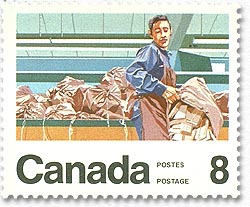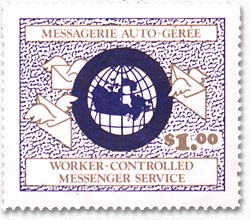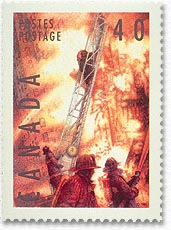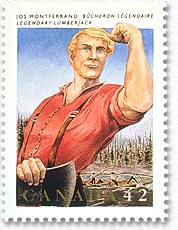

One group of workers who consistently attract the attention of post offices, both in Canada and elsewhere, are the postal workers themselves. They can be found on stamps as early as 1953, when the post riders of 18th-century Québec were commemorated (#413). The post is also the subject of a series of six stamps from 1974 documenting various phases of contemporary postal operations (#634-639). Here perhaps we are beginning to see the more general gaze of inclusion give way to a more direct gaze of assertion. In some respects the intentionality may be indirectly related to the unhappy labour relations climate of the 1970s at the post office, where large battles were being fought over technological change and labour rights. Although this was a time of considerable conflict over technological change in the post office, the image of the postal worker seems to be thoroughly unaffected by such matters. We are forcefully reminded of this situation by one of two unique stamps issued by the Canadian Union of Postal Workers in 1975. During the course of that year's labour conflict, the postal workers undertook to provide some limited service for which they issued alternate stamps under the title "Worker-Controlled Messenger Service."
Canada Scott 636
Stamp reproduced courtesy of Canada Post Corporation
|
 |
 |
"Worker-Controlled Messenger Service," 1975
Issued by the Canadian Union of Postal Workers.
|
Another group of workers are honoured on four stamps issued in 1991. These stamps paid tribute to a number of "Dangerous Occupations" (#1330-1333), including ski patrols, police, fire-fighting, and search and rescue. Again, this must be considered a limited assertion of the working-class presence. Certainly experts on workplace health and safety will ask whether these are thought to be the only or even the most dangerous of occupations for Canadian workers.
Canada Scott 1332
Stamp reproduced courtesy of Canada Post Corporation
|
 |
In a category of their own are a group of near-legendary individuals who have achieved larger than life reputations. In 1992 the group included, besides Laura Secord who has a somewhat different status, the Ottawa Valley lumberman Joseph Montferrand, the Newfoundland seafarer William Jackman, and the Prairie guide Jerry Potts (#1432-1435). All of these are actual historical figures, ratified as such by the Dictionary of Canadian Biography, but they are smuggled into the postal issue under the formal classification of Canadian folklore. The same transaction takes place also in 1993 (#1491-1494) where several workers, including the men who sang "Les Raftsmen" on the timber drives and the fishermen who sang "I's the B'y" in the outports, are represented under the classification of folk song. And if hockey players can be considered part of labour history, they too can be found on stamps celebrating the 75th anniversary of the National Hockey League in 1992 (#1443-1445); certainly we now know that hockey players in the 1950s and after have been engaged in some difficult off-ice struggles against the league owners.
 |
Canada Scott 1435
Stamp reproduced courtesy of Canada Post Corporation
|
We may also pause here to consider the presence of individuals whose lives can be read, at least in part, as chapters in the larger working-class experience. We might consider including here such figures as Alexander Mackenzie (#319), the apprentice stonemason, or David Thompson (#370), the Hudson's Bay Company apprentice, both of whom went on to larger prominence in Canadian history. We might also make claims for individuals who gained world reputations through their work, such as the champion oarsman Ned Hanlan (#862) and the renowned soprano Emma Albani (#860).
Consider as well the cases of those who were connected to various causes of popular democracy and the left in Canadian history. The gaze of assertion here includes individuals such as Louis Joseph Papineau (#539), Louis Riel (#515), Josiah Henson (#997), and Gabriel Dumont (#1049) - but not William Lyon Mackenzie. It also includes Norman Bethune (#1254-5)22 and Agnes Macphail (#1293) - but not J.S. Woodsworth.
|



